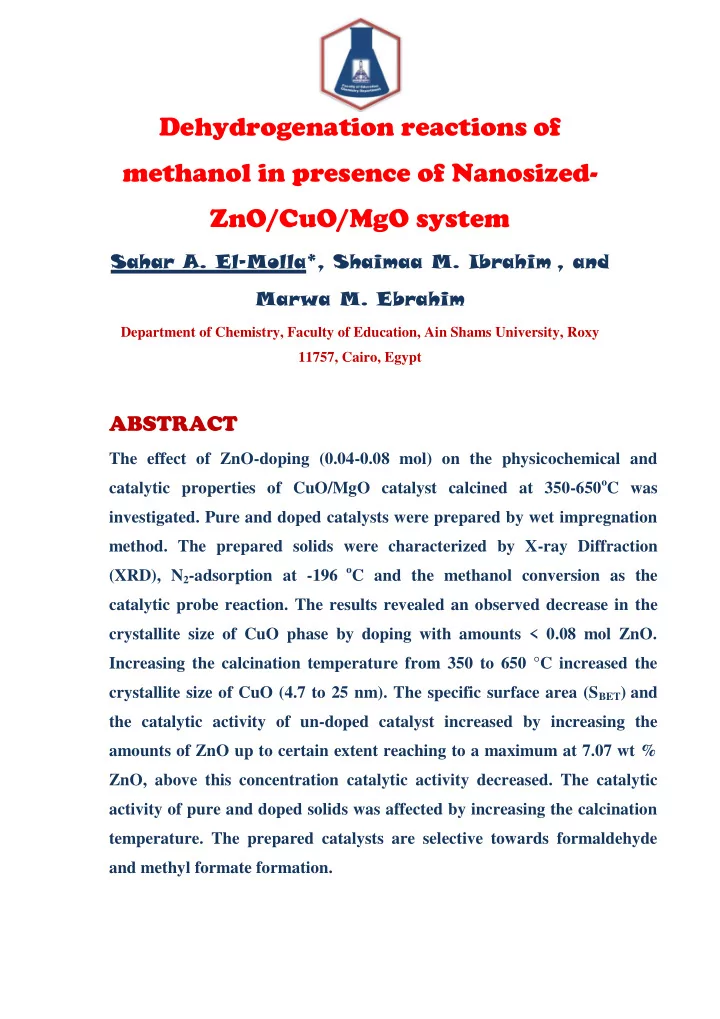

Dehydrogenation reactions of methanol in presence of Nanosized- ZnO/CuO/MgO system Sahar A. El-Molla*, Shaimaa M. Ibrahim , and Marwa M. Ebrahim Department of Chemistry, Faculty of Education, Ain Shams University, Roxy 11757, Cairo, Egypt ABSTRACT The effect of ZnO-doping (0.04-0.08 mol) on the physicochemical and catalytic properties of CuO/MgO catalyst calcined at 350-650 o C was investigated. Pure and doped catalysts were prepared by wet impregnation method. The prepared solids were characterized by X-ray Diffraction (XRD), N 2 -adsorption at -196 o C and the methanol conversion as the catalytic probe reaction. The results revealed an observed decrease in the crystallite size of CuO phase by doping with amounts < 0.08 mol ZnO. Increasing the calcination temperature from 350 to 650 °C increased the crystallite size of CuO (4.7 to 25 nm). The specific surface area (S BET ) and the catalytic activity of un-doped catalyst increased by increasing the amounts of ZnO up to certain extent reaching to a maximum at 7.07 wt % ZnO, above this concentration catalytic activity decreased. The catalytic activity of pure and doped solids was affected by increasing the calcination temperature. The prepared catalysts are selective towards formaldehyde and methyl formate formation.
Keywords: ZnO-doping; CuO/MgO system; Methanol Conversion; Selectivity. Figure 1 XRD diffractograms of pure and ZnO doped CuMgO solids precalcined at 550 ºC. Lines (1) refer to MgO, lines (2) refer to CuO phases.
Figure 2 XRD diffractograms of pure and ZnO-doped CuMgO solids precalcined at 350 and 650 ºC. Lines (1) refer to MgO, lines (2) refer to CuO phases.
Table1. The specific surface areas of pure and ZnO-doped 0.3CuO/MgO adsorbents precalcined at 550 and 650 o C r - Moles of Calcin. S BET V p (m 2 /g) cm 3 /g ZnO Temp. °C Å 0 550 21 0.108 103 0.06 550 28 0.109 78 0.08 550 32 0.102 64 0 650 16 0.052 65 0.06 650 22 0.048 44
Figure 3 Total conversion of methanol as a function of reaction temperature over (A) CuMgO (B) 0.06 mol ZnO-doped CuMgO sample at different calcination temperatures.
20 18 o C at 125 a: CuMgO 16 Total conversion % b: +0.04 mol ZnO 14 c: +0.05 mol ZnO 12 d: +0.06 mol ZnO 10 e: +0.08 mol ZnO 8 d c b 6 a 4 e 2 0 Catalyst 70 d o C at 150 60 c Total conversion % b a 50 e 40 30 20 10 0 Catalyst Figure 4 Total conversion of methanol at 125 and 150 o C over pure and variously ZnO-doped CuMgO samples calcined at 550 o C.
Table 2. Selectivities of Undoped and ZnO- doped catalysts towards methanol conversion. The Solids Calcination Selectivities 125 150 175 200 225 250 275 Temperature ºC ºC ºC ºC ºC ºC ºC 0.3CuMgO 350 ºC S m % 100 12.4 41.6 49.8 53.9 55.5 57.8 S f % 0.00 87.6 58.4 50.2 46.1 44.5 42.2 +0.06ZnO 350 ºC S m % 73.7 14.3 38.4 47.9 52.4 55.3 57.4 S f % 26.3 85.7 61.6 52.1 47.6 44.7 42.6 550 ° C 0.3CuMgO S m % 100 17.1 42.7 45.9 48 53.2 58.6 S f % 0.00 82.9 57.3 54.1 52 46.8 41.4 550 ° C +0.04ZnO S m % 42.1 16.9 47.1 49.9 52.2 55.2 56.8 S f % 57.9 83.1 52.9 50.1 47.8 44.8 43.2 550 ° C +0.05ZnO S m % 58.2 18.3 46.8 49.8 53.1 54.7 57.1 S f % 41.8 81.7 53.2 50.2 46.9 45.3 42.9 550 ° C +0.06ZnO S m % 49.6 22.9 42.3 48.1 49.6 52 51.6 S f % 50.4 77.1 57.7 51.9 50.4 48 48.4 550 ° C +0.08ZnO S m % 100 16.1 42.2 45 49.5 50.8 58.2 S f % 0.00 83.9 57.8 55 50.5 49.2 41.8 0.3CuMgO 650 ºC S m % 100 8.5 41.2 48.8 53.7 56.5 58.1 S f % 0.00 91.5 58.8 51.2 46.3 43.5 41.9 +0.06ZnO 650 ºC S m % 64.9 10.5 40.9 45.2 51.7 56 58.3 S f % 35.1 89.5 59.1 54.8 48.3 44 41.7 S m : selectivity to methyl formate S f : selectivity to formaldehyde
Conclusi Conclusion ons The physicochemical and catalytic properties of CuMgO system are affected by ZnO-doping and calcination temperature. The crystallite size and ordering of CuO phase decreases by ZnO-doping for samples calcined at 350 – 550 o C reached to (4 nm). Increasing the calcination temperature from 350 to 650 °C led to increasing the crystallite size of CuO (4.7 to 25 nm) in the investigated samples. The BET surface area and catalytic activity of CuMgO catalyst increases by increasing the amounts of ZnO up to certain extent reaching to a maximum at 7.07 wt % ZnO, above this concentration catalytic activity of doped samples decreases. The catalytic activity of pure and doped solids increase by increasing the calcination temperature from 350 to 550 ºC can be due to formation new active sites, above this temperature the catalytic activity and selectivity decrease. The prepared catalysts were selective towards formaldehyde and methyl formate formation due to the presence of dehydrogenation sites.
Recommend
More recommend